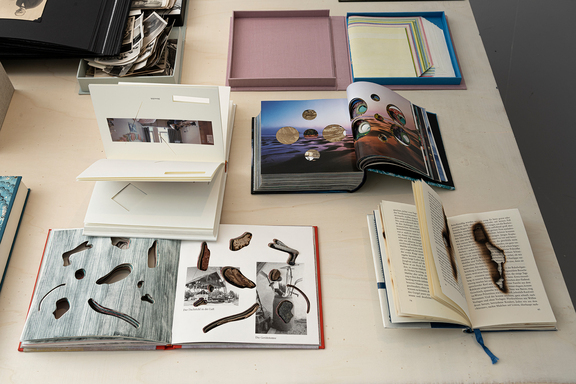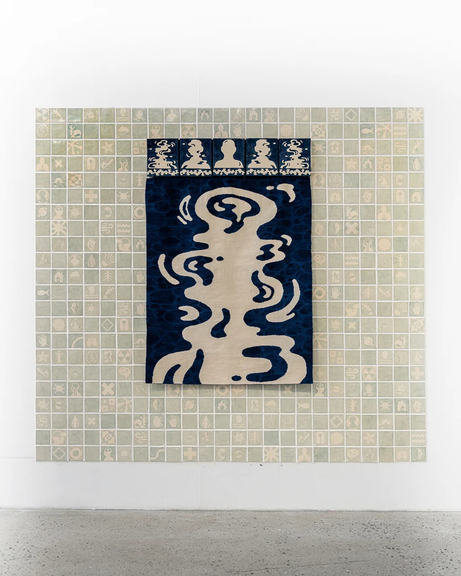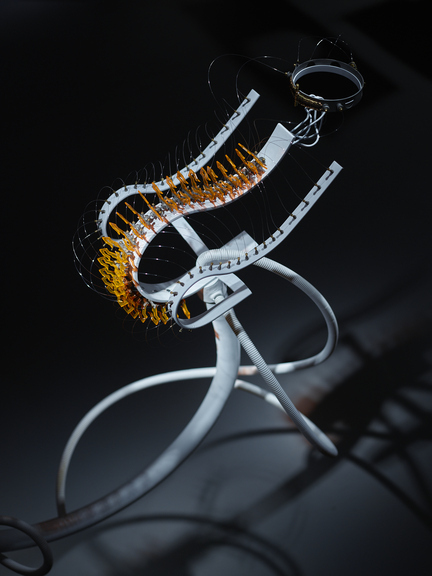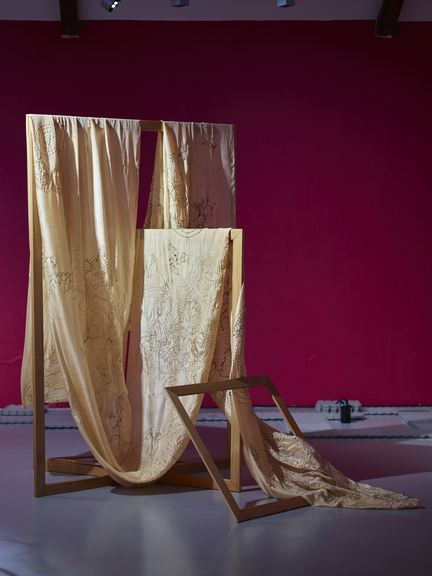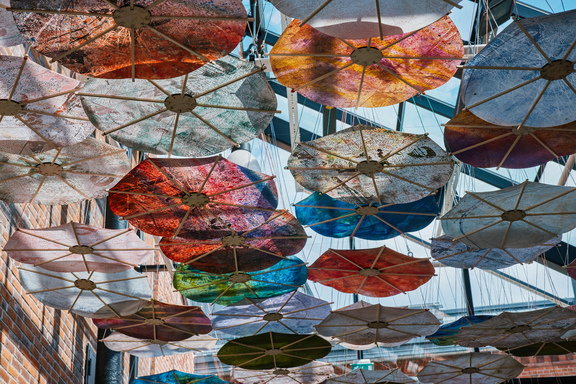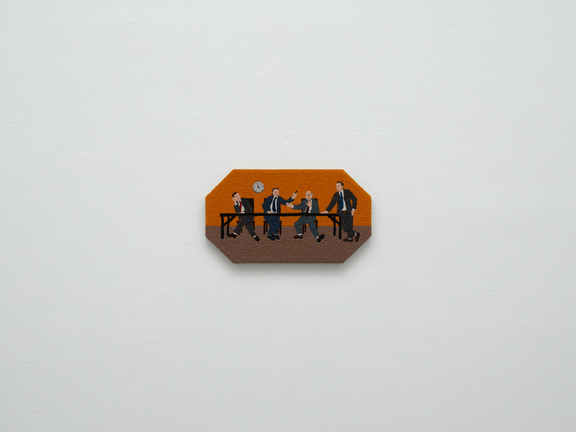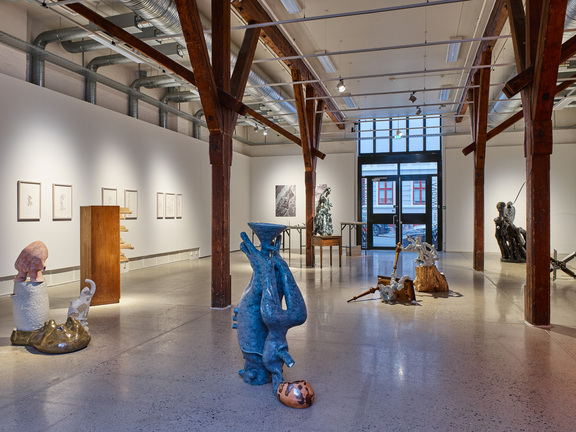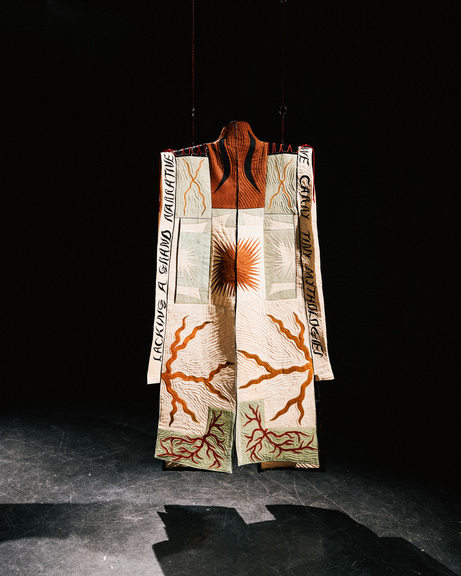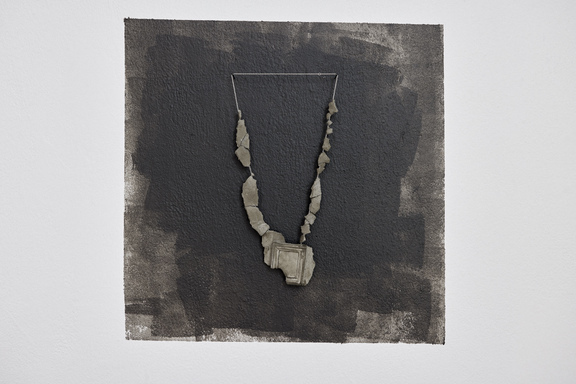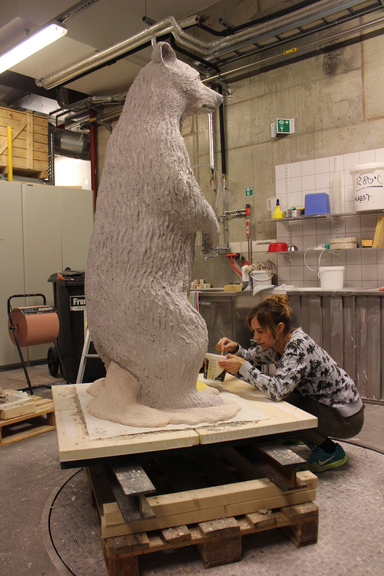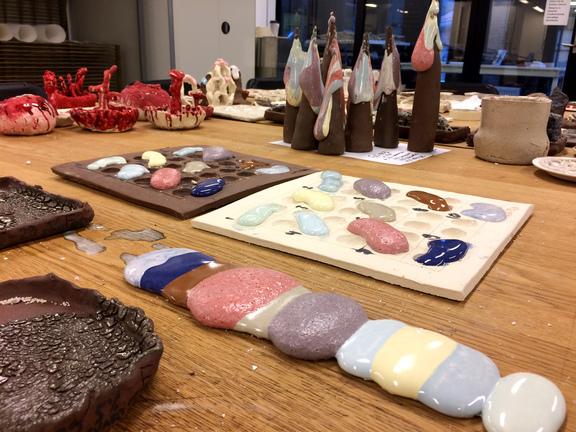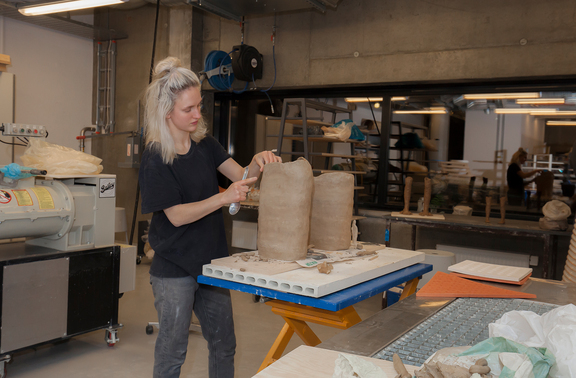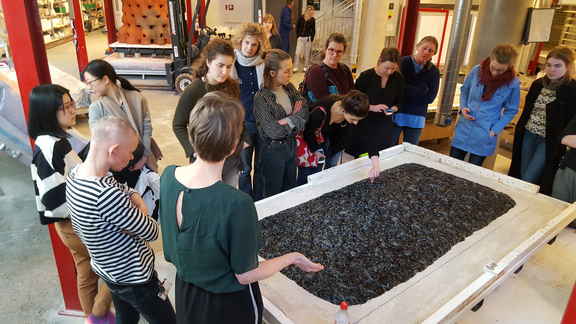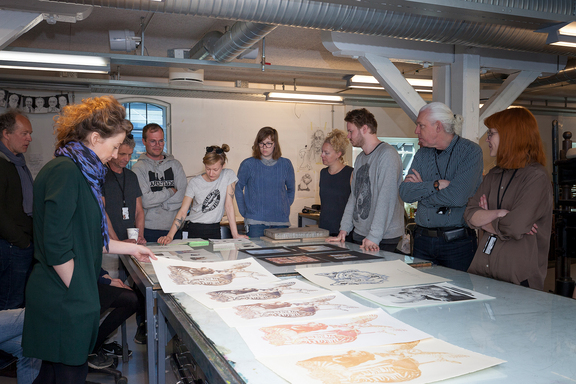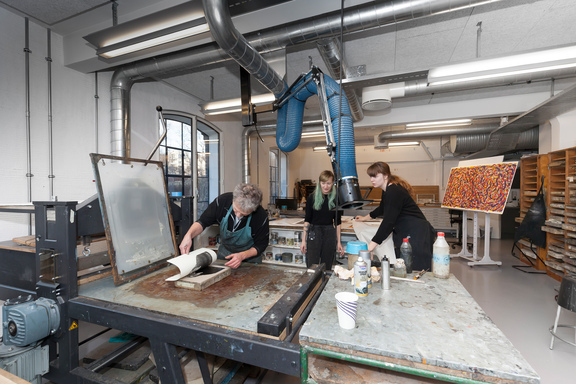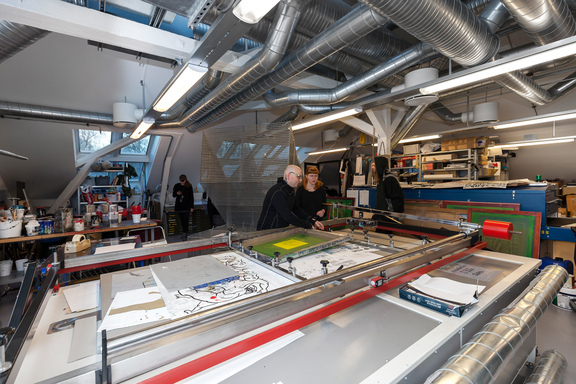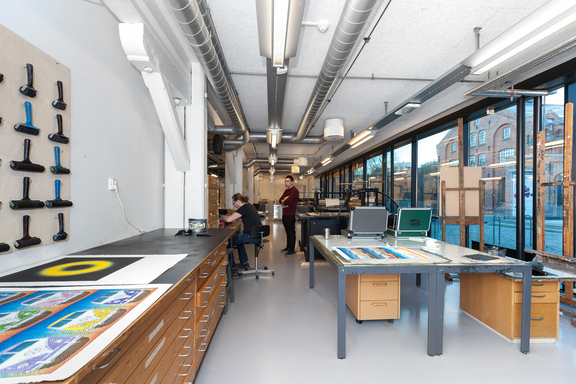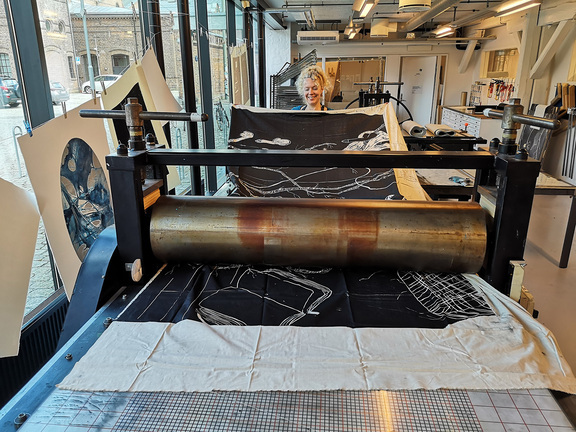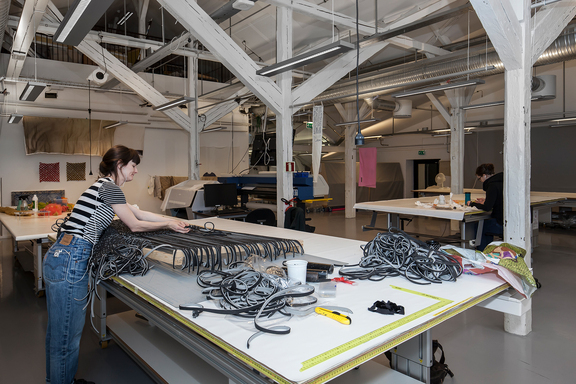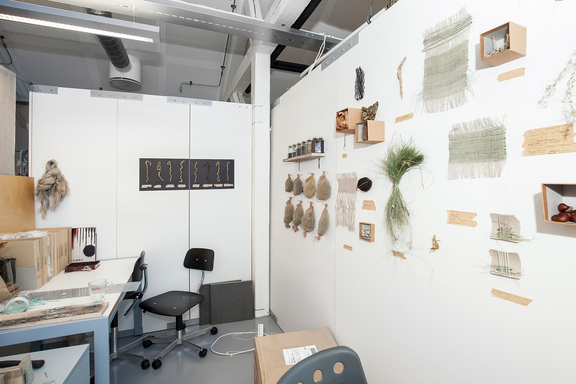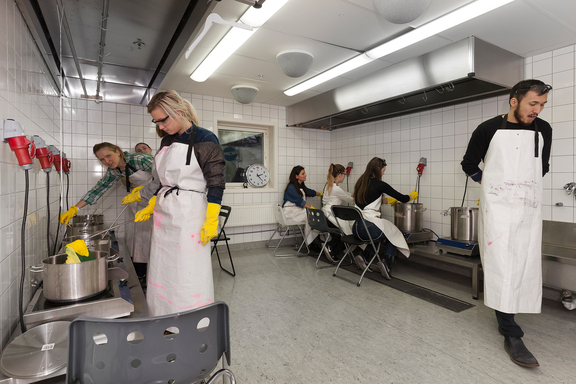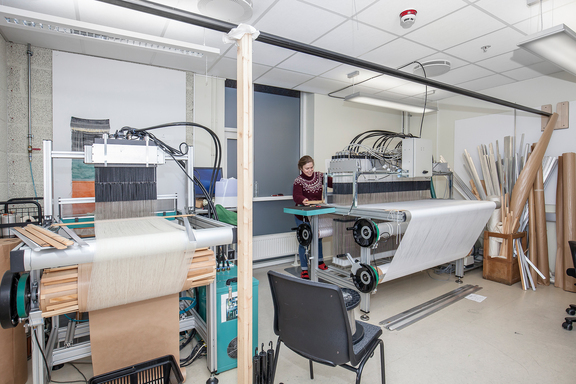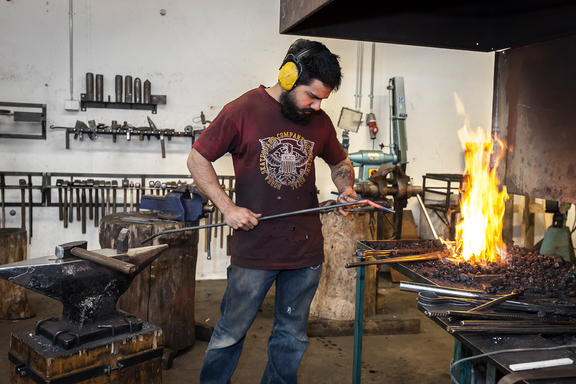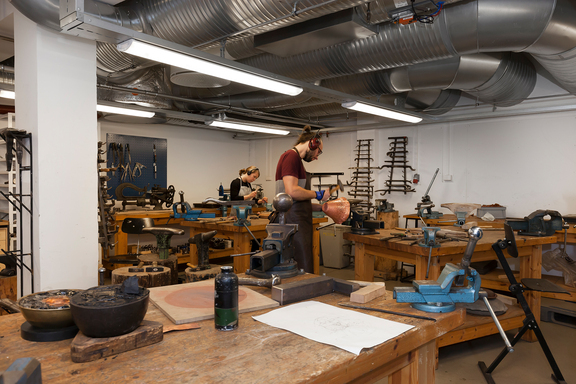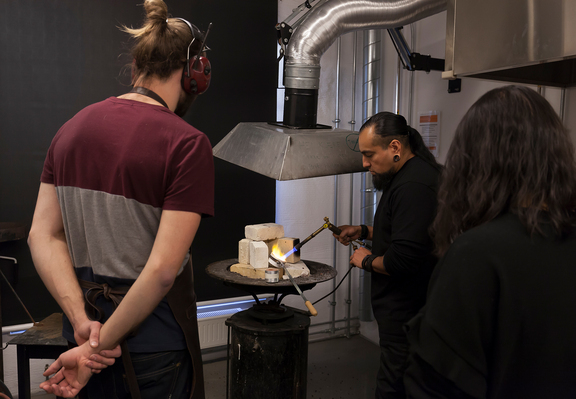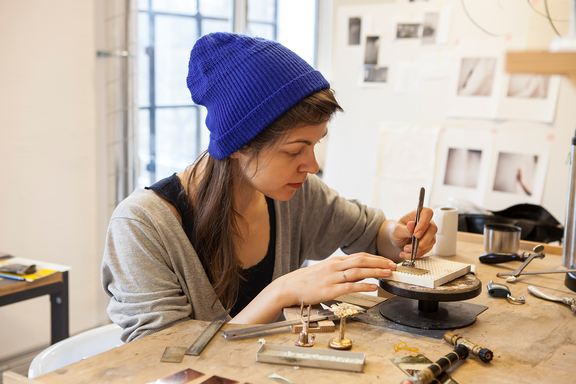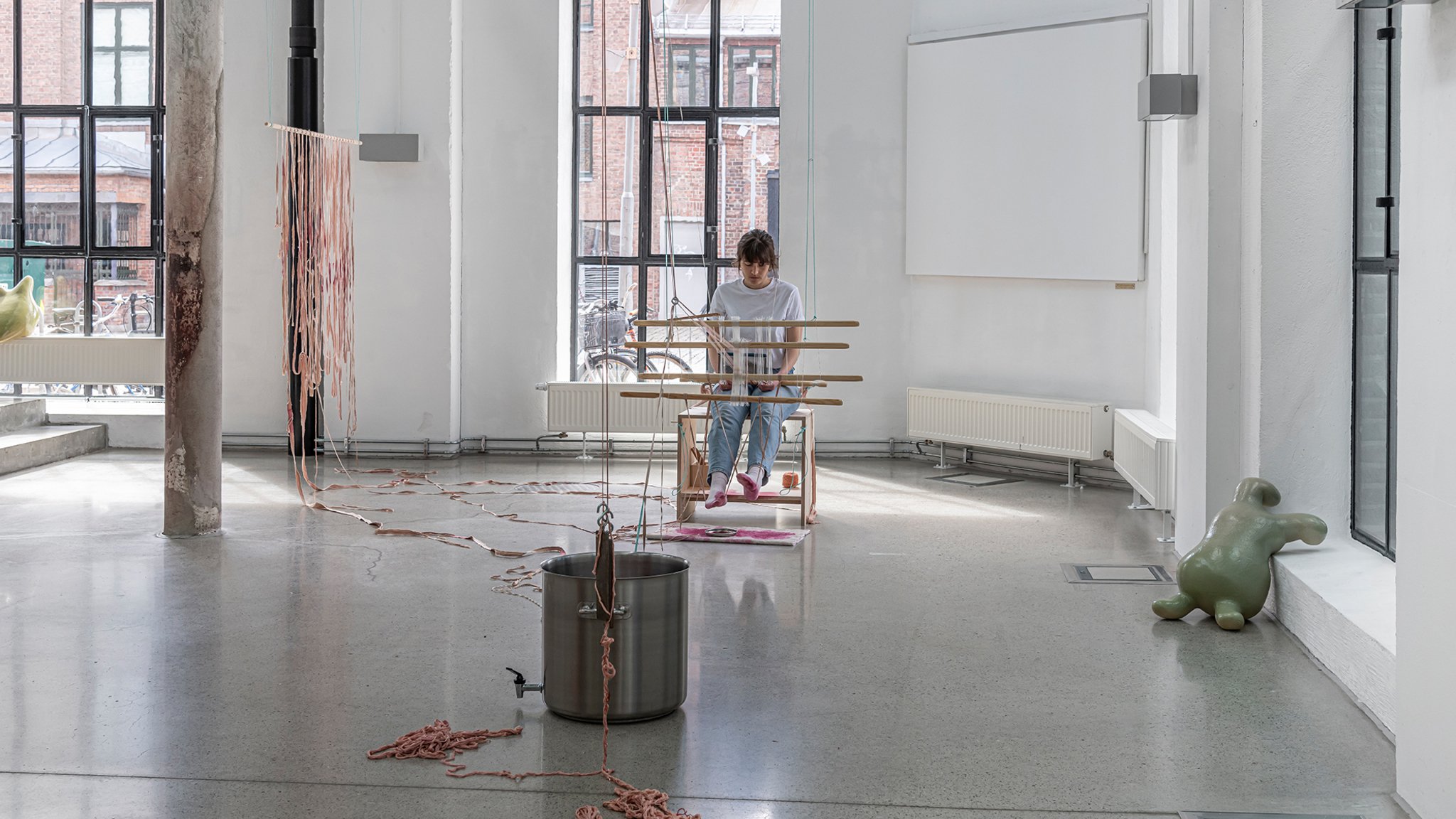

MFA in medium- and material-based art
In the MFA programme in medium- and material-based art, students work on developing their own artistic practice. They are given the opportunity to further their research and development in the disciplines of ceramics, textile, print and drawing, metal and jewellery. The programme’s interdisciplinary structure promotes collaboration and innovation across the various areas of specialisation. The study emphasises artistic independence and encourages an experimental and interdisciplinary approach to the department’s range of specialisation areas.
Students are assigned a main tutor and allocated a workspace in one of the specialisation areas. The programme combines individual tutoring with hands-on workshops, group critiques, seminars, lectures and student-led study groups. Exhibition Practice and Writing Practice are integral components of the MFA programme. As part of the studies students gain insight into methods of artistic research and development. The international learning environment accommodates English-speaking students. The programme is a two-year, full-time course.
Ceramics
At the MFA in medium- and material-based art you can specialize in Ceramics.
Ceramic art encompasses a broad array of artistic approaches to the use of clay and ceramics. Ceramic art is closely connected to the field of contemporary craft as well as to fine art and design, and it has played an influential role throughout art history. In this specialisation you will work on your own individual projects under the supervision of professional, practising artists. The wide range of skill sets to be found among the section’s staff within ceramics allows our students to approach the field in a variety of ways. We actively draw upon our contacts in the international ceramics art community in lectures and seminars, as well as in the guise form of invited guest artists.
By working hands-on in the workshops, you will explore materials, techniques and conceptual strategies and methods with an eye towards becoming more aware of your own artistic idiom and style. The overall goal of the teaching is to provide broad insight into the field of ceramic art, in addition to providing you with the knowledge and skills that are needed to work as a professional ceramic artist.
Print and Drawing
At the MFA in medium- and material-based art you can specialize in Print and Drawing.
The focus in this specialisation is on graphic techniques such as intaglio, lithography, screen printing and relief printing as well as photo-based processes in these media. The specialisation also includes drawing and book art.
The radical transformations in the field of printmaking in recent years have changed modern approaches to the medium. Printmaking is a democratic form of expression that may include everything from posters and inscribed buttons to clothes, cakes and graffiti. Prints may also include printed medium-density fibreboards (MDFs) and digitally manipulated silk screens, tapestries incorporated in installations, or woodcuts where the matrix itself takes centre stage in the work. Printmaking thus turns up in a variety of forms within the wider field of graphic art.
Drawing is closely related to graphic forms of expression and covers everything from sketches and drawing as developmental and conceptual tools to drawing as a unique form of art, and to drawing combined with other materials and techniques. Drawing has gradually become an important idiom in contemporary art, whether expressed on paper, walls or tablets, showcased in artist’s books, or conveyed through other techniques of mass production.
Textile
At the MFA in medium- and material-based art you can specialize in Textile.
Textile art represents a way of thinking, creating, writing and expressing ourselves. In this specialisation, you will learn to dye fibres using chemical recipes and plants, spin yarn and read philosophy, art history and political theory. Weaving, prints and embroidery all serve to express our ideas in multi-layered ways.
At the Academy, textile art is taught through practical instruction in workshops and through seminars where students learn about textile practices, dying, analogue and digital weaving, silk screens, digital/analogue textile prints and digital/analogue embroidery. We are regularly visited by national and international guest artists, curators and theorists. As a student you will be supervised both individually and in groups. We also have auditorium-based teaching in theory and art history.
Metal and Jewellery
At the MFA in medium- and material-based art you can specialize in Metal and Jewellery.
We offer Norway’s only higher education art programme that specialises in jewellery art and object design. Jewellery creates identity and is personal, but it is worn and communicated in a social setting. Objects, corpora and sculptures are also conveyors of meaning, with tradition serving as the basis for innovation and artistic processes. This specialisation also explores site-specific art and public art.
The teaching is based on artistic praxis with a focus on craft and materials, in parallel with art theory and methodology. Experimentation and exploration, both practical and conceptual, are strongly emphasised. The Academy’s workshops are unique, and as a student you will have the opportunity to learn more about techniques such as soldering, founding, forging, welding and patinating. You will primarily work on individual projects under the supervision of professional practitioners. We organise seminars, lectures and discussions. As a student you will benefit from a large professional network and a wealth of international guest teachers.
Programme description
This programme description is valid from the Autumn semester of 2017.
Brief programme description
This is a multi-disciplinary Master of Fine Art programme in medium and material-based art. The focus is on the development of each student’s individual art practice through the processes of art making and a creative, critical engagement with medium and material-based art. It is an intensive and demanding programme that stimulates and encourages experimental and interdisciplinary approaches to the department’s unique combination of art and craft areas. Working with writing exercises, such as project descriptions and the examination thesis, is a central part of the studies, and shall lead to reflection on- and contextualisation of the student’s own artistic practice.
It is a two-year full-time study that gives 120 academic credits (ECTS). Each semester accounts for 30 credits. The development and progress of each student is assessed during and at the end of each semester. A pass of each semester assessment is a requirement for continued studies. The programme demands a high level of independent and disciplined study. Students are expected to demonstrate an investigative approach and a capacity for in-depth research. The language of tuition is Norwegian and English.
The structure of the programme is divided into three interdependent and overlapping course categories: Art Practice; Contextualisation; Exhibition Practice.
The Art and Craft department offers four areas of medium and material specialisation:
Metal art and Jewellery
Ceramic art
Printmaking and Drawing
Textile art
Each student is assigned a main tutor and a workspace based on the student’s area of specialisation. Master students at the Art and Craft department have access to the facilities and teaching resources at all four areas of specialisation, including the media lab, publication studio, dForm/digital 3d, spatial laboratory etc. See www.khio.no for further information on all the workshop facilities.
In addition to the Art and Craft department, Oslo National Academy of the Arts consists of the following departments: the Academy of Fine Art, the Design department, and the three Academies of Performing Arts. Students from the Art and Craft department have the opportunity to attend selected lectures and workshops organised by the other departments.
Completed MFA studies qualify for artistic practice at a high professional level and functions as the foundation for further studies such as the Norwegian Artistic Research Programme and other relevant PhD programmes.
Admission requirements
Admission to the master programme requires a three-year Bachelor’s degree in visual arts or a relevant undergraduate degree composed of subjects or courses of which at least 80 study credits are relevant to the study programme. [180 ECTS credits or equivalent according to §§3-4 of the Norwegian Universities and Colleges Act.]
In certain cases admission may be considered on the basis of other documented qualifications that are fully or partially equivalent to the above-mentioned academic requirement.
An applicant’s qualifications, skills and aptitude for the master programme are considered in relation to an overall assessment of their portfolio, letter of motivation, documented artistic involvement and other relevant qualifications. Admission to the programme is based on nomination by an interdisciplinary committee that consists of teaching staff from the various areas of specialisation, one member can be external representative, and one student observer.
The application must include documentation of completed studies, a digital portfolio containing visual documentation of the applicant’s own artworks, and a letter of motivation.
Applicants may be required to attend an interview.
Applicants must be proficient in English.
Learning outcomes
Upon completion of the master programme, students shall be able to:
- establish a professional artistic practice
- communicate knowledge of materials and technical skills required for a high level of artistic practice
- demonstrate critical reflection and ethical awareness through their own practice viewed in context
- demonstrate an advanced understanding of the methods, theory and cultural significance of contemporary art
- develop, complete and present an independent art project in a professional context
- demonstrate insight into artistic research through their own practice
- articulate and communicate their work using relevant language and terminology
- initiate and manage art projects
Structure and progression
The workload in each course is describes using the term credits. The two-year full time Master’s programme qualifies for a total of 120 ECTS credits (European Credit Transfer System). One credit amounts to approximately 25 to 30 actual hours of study for the student. Activities that qualify as study hours include independent study, participation in tutorials, lectures, seminars, study groups, written assignments, exhibitions etc.
The master studies require a large amount of independent work and active participation in the mandatory components. Each semester is comprised of 30 credits. Passing every semester is a requirement for continuation in the programme.
The Master programme contains three interdependent course categories:
Art Practice, 75 credits
Independent work and individually directed research is central to the programme. The student’s art practice is developed in dialogue with their main tutor. The student develops an independent art practice through individual exploration and research-based methods.
The student’s artwork and thesis (written part of final examination) shall identify and define the student’s individual aims, artistic perspectives and working methods. The ability to demonstrate critical reflection and contextualisation of artistic practice/master project are essential aspects.
It is recommended that the thesis should contain 5 - 18 pages standard A4 pages of text.
Tutorials with teaching staff and visiting art professionals, group critiques, various workshops, lectures and study trips support and develop the student’s artistic practice. The studies shall result in an understanding of ones own artistic work and context, so that the student can work independently as an artist/craft practitioner when the studies are concluded.
Contextualisation, 25 credits
Contextualisation includes art theory and cultural theory relevant to medium and material-based art. This course category deals with the identification of social, intellectual and cultural influences, and the situating of your art practice in a larger context. It includes theory seminars, writing workshops and reflective writing. Topics related to theory, reflection and methodology are adapted to fit the semester structure in various forms. Tutoring is organised as individual tutorials, group critiques, student presentations, lectures and workshops.
Contextualisation in the form of theory seminars covers themes that can range from general art theory to specific topics concerning medium and material-based art. Through various modes and methods of developing critical reflection and discursive ability the students learn to identify social and cultural influences, explore sources and references, and discuss ideas and strategies.
Writing practice is an integral part of contextualisation. Writing and text production takes various forms such as artist statements, project descriptions and the development of the examination thesis.
The content of the tuition shall contribute to giving the students advanced and specialised knowledge that strengthens each student’s individual art practice. The tuition aims to provide theoretical and methodological tools that enable the articulation of artistic projects at an advanced level.
Exhibition Practice, 20 credits
Exhibition practice includes topics that will prepare students for their profession.
Master One Show (First year)
This exhibition takes place during the second semester (spring) of the first year. It involves the development of individual projects and collaborative work with support from teaching staff.
Degree Exhibition (Second year)
The preparation, concept development and completion of the Degree Exhibition are carried out in close collaboration with the appointed curator/coordinator and fellow students. Tuition involves regular meetings, tutorials, group discussion and reviews, and related workshops. The development of the Degree Exhibition requires active participation with the production of the catalogue, press and media, exhibition installation, public presentation, possible sponsorship etc
Exchange
The Oslo National Academy of the Arts facilitates study exchange periods at other institutions during the programme period.
The Art and Craft department is a member of the Nordic network’s CIRRUS, Nordplus, and ERASMUS programmes. In addition, bilateral agreements exist with institutions outside these networks.
Exchange programmes allow students to complete one semester at an overseas institution, with the credits earned counting towards their Master’s degree. In certain cases of academic collaboration projects, the dean may accept an exchange of up to one year. An application of motivation and purpose for the exchange is required.
Students may also participate in “express mobility” opportunities such as weeklong workshops or shorter courses or projects that can form part of their Master studies.
It is recommended that exchanges take place during the second semester of the Master’s programme. Exchanges are arranged and conducted in dialogue with the student's main tutor. A written statement of purpose and motivation for the period of study abroad must be submitted to the programme coordinator for approval.
These exchange agreements are valid for mfa in medium- and material-based art:
Teaching and learning methods
The programme structure contains both individual and general components. The individual component is primarily the student’s independent work and specialisation in dialogue with their main tutor and other teaching staff. The general component complements and supports the individual component and is comprised of student presentations, group critiques, tutorials, lectures and seminars. Writing practice and exhibition practice are an integral part of the programme. Student-initiated and student-led projects are encouraged. Study trips are an optional part of the programme.
Tuition is in Norwegian and English.
Tuition
All students are assigned a main tutor from the Art and Craft department.
Students are to plan their individual studies, specify interests and problems, communicate tuition needs and make decisions on the progress of their artistic practice. The main tutor helps the student to plan their individual studies, contributes to clarify relevant artistic and methodological aspects, assists in the development of the master thesis, and is responsible for assessing the student’s artistic progress. Students are encouraged to have tutorials with other teaching staff and visiting art professionals.
In certain cases the main tutor or student may wish to terminate the collaboration. If the student wishes to terminate the collaboration, they must submit a formal application to the programme coordinator, and if possible a new main tutor will be assigned.
Workspace
Each student is allocated a workspace at one of the four areas of specialisation. A large part of the studies are carried out in shared work studios and project rooms. Access to individual project spaces is granted upon application to/in dialogue with the head of specialisation area/main tutor.
In order to keep the right to a workspace, students must show evidence of progression in their studies, and that they make use of their workspace.
Study requirements:
A minimum of 80% attendance is required for all tutor-led teaching. Tutor-led teaching includes individual tutorials, group tutorials and critiques, lectures, writing-practice workshops, theory seminars and specialised workshops/courses.
Each semester must be given a pass, in order to continue the programme. Conditions relating to absence and to leave of absence are laid down in the Academic Regulations for the Oslo National Academy of the Arts (Forskrift om studiene ved Kunsthøgskolen i Oslo).
Assessment
The study requirements for the course have to be approved in order for the student to receive the final assessment.
The student’s work and progress is assessed throughout each semester. A formal assessment takes place at the end of each semester.
At the semester assessment each student presents their work to an assessment committee comprised of their main tutor and another member of the teaching staff. A brief report is delivered to the committee in advance of the student’s presentation. The presentation can include artworks, digital documentation and texts. The assessment committee reviews the student’s practice and progress together with the student.
A pass of each semester assessment is a requirement for continuation in the programme.
The Master’s programme concludes with the final degree examination in the fourth semester. The final examination involves the assessment of the courses Art Practice 4 and Exhibition practice 3.
Examination procedure: prior to the final examination the student shall submit their examination thesis/essay, consisting of between 5 – 18 standard A4 pages of text. The text is a complement to the student’s artwork, and shall include an expanded artist’s statement, critical reflections on their artistic practice, contextual references, and a summary of the student’s studies as a whole.
For the final examination the student shall complete and present their art work, installed and presented in a suitable exhibition context (gallery, outdoor space, etc.) Additional background and supplementary material documenting the process can also be presented to the examiners.
Two external examiners and the student’s main tutor conduct the examination. The examination follows the specified exam procedure.
The final examination of the student’s work is assessed in accordance with the learning outcomes for the programme and the assessment criteria for the examination.
All courses are assessed as Pass or Fail.
Further conditions of assessment and procedure for the final examination are laid down in the Academic Regulations for the Oslo National Academy of the Arts.
Quality assurance
The Oslo National Academy of the Arts has in place systems to ensure and further develop the quality of all aspects of the education it offers. Students make important contributions to this work, for example by participating in student evaluations and the annual Learning Environment Survey.
Course structure
| Course code | Course name | ECTS Credits |
|---|---|---|
| MK501 | Art Practice 1 | 20 |
| MK502 | Contextualisation 1 | 10 |
| MK511 | Art Practice 2 | 15 |
| MK512 | Contextualisation 2 | 10 |
| MK513 | Exhibition Practice 1 | 5 |
| Course code | Course name | ECTS Credits |
|---|---|---|
| MK521 | Art Practice 3 | 20 |
| MK522 | Contextualisation 3 | 5 |
| MK523 | Exhibition Practice 2 | 5 |
| MK531 | Art Practice 4 | 20 |
| MK533 | Exhibition Practice 3 | 10 |
Admissions
The application deadline is February 01, 2026 23:59
About the Art and Craft department
The Art and Craft department offers an art training in the fields of ceramics, textile, print and drawing, metal and jewellery, art and public space.
